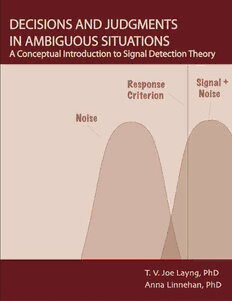
Decisions and Judgments in Ambiguous Situations A Conceptual Introduction to Signal Detection Theory PDF
198 Pages·2022·11.646 MB·English
Most books are stored in the elastic cloud where traffic is expensive. For this reason, we have a limit on daily download.
Preview Decisions and Judgments in Ambiguous Situations A Conceptual Introduction to Signal Detection Theory
Description:
There are times when we are unsure as to whether or not an event has actually occurred. When stimuli or events are ambiguous, what governs saying “yes” it is there or “no” it is not? Is that smile meant for us? Is that shadow on the x-ray a tumor? Are there people here I’m unprepared to meet? If I try, will I succeed? Is it SD or is it S∆? What governs our behavior in these situations? Decisions and Judgments in Ambiguous Situations reveals important variables that years of laboratory and applied work have demonstrated to contribute to our understanding of these complex relations through the lens of Signal Detection Theory (SDT). SDT was developed to describe behavior where stimuli to which we need to respond are embedded in “noisy” environments, where there is uncertainty rather than clarity.Readers are taken through exercises in guided enquiry that introduces them to some of the key variables that influence our decisions in ambiguous situations. Each exercise is designed to be challenging yet easily mastered. Readers are introduced to the concepts of signal and noise, the role of consequences in a payoff matrix, response bias, discriminability (sensitivity), decision rules, and the effects of the a priori probability that an event will occur on our judgments. As one of the foundations of nonlinear contingency analysis, readers will learn that being “wrong” at times can be precisely what should be done, and that optimal patterns of correct and incorrect responding can change for the exact same stimulus presentations. Whereas introductions to SDT often involve complex mathematics, this one does not. Little math, outside of addition and division, is required. Upon completion of the book, readers will have a good grasp of the underlying concepts and will be able to apply them, including the ability to design and conduct SDT experiments. It is a must read for any student of behavior analysis who wants to extend their repertoire beyond simple ABC analysis and to understand more complex behavioral relations.
See more
The list of books you might like
Most books are stored in the elastic cloud where traffic is expensive. For this reason, we have a limit on daily download.
